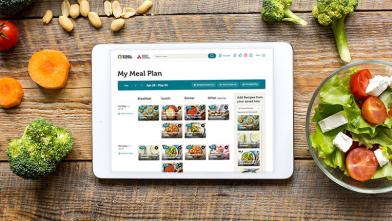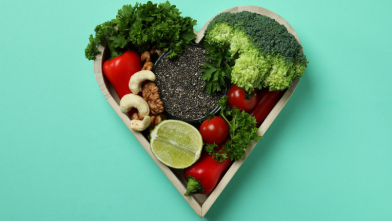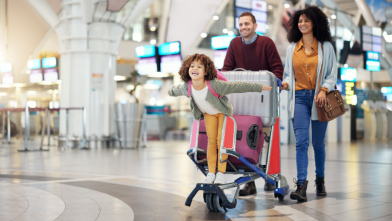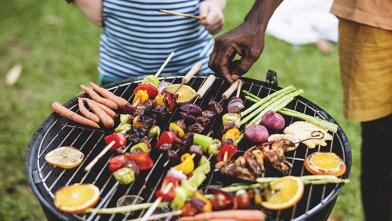Plant-based meals are packed with nutrients and minerals that are great for keeping the body powered. Even if you aren’t vegetarian or vegan, swapping a plant-based meal in one or twice a week could be beneficial. But how does that work with the Diabetes Plate?
The Diabetes Plate is a simple way to eat a lower carb, balanced meal. Created by the American Diabetes Association’s nutritional experts, this easy-to-follow method of meal planning and eating requires no measuring, weighing, or calculating. Using a 9-inch plate, fill half with non-starchy veggies. Then split the other half with ¼ carbohydrate foods and ¼ protein foods.
Here are some easy how-to tips (with chef-inspired upgrades!) for using the Diabetes Plate for plant-centered eating.
How to Use the Diabetes Plate
1. Fill half your plate with non-starchy vegetables.
This is the easy part—and provides nutrient-richness, flavor, and color to your plate or bowl. Pick green beans, orange peppers, purple eggplant, red cabbage, white mushrooms, yellow summer squash, and beyond. It can make breakfast, lunch, or dinner seem bigger, too.
Cuisine ideas:
- Garlic bok choy
- Roasted carrots with dill or mint
- Simple roasted bell peppers
- Seasonal heirloom tomato salad
2. Fill one-quarter of your plate with plant-based protein foods.
Choose an exciting array of plant protein foods, including pulses (dry beans, dry peas, chickpeas, and lentils), nuts, seeds, or plant-based meat alternatives. Don’t forget other protein-packed foods made from plants, like tempeh or tofu (from soybeans), seitan (from wheat), and hummus (from chickpeas).
Cuisine ideas:
- Pan-grilled tofu skewers with gingery marinade
- Black bean burger patty with guacamole
- Tempeh with fruit-sweetened BBQ sauce
- Falafel (chickpea fritters) with lemony-tahini sauce
3. Fill one-quarter of your plate with carbohydrate foods.
Round out meals by selecting from starchy vegetables, fruits, breads, cereals, rice, or pasta, You could also use dairy, yogurt, or milk in this section. When choosing grains, aim for whole grains.
Pro tip: Pulses (like beans) are considered carbohydrate foods. For plant-based meals, consider keeping these only in the protein category.
Cuisine ideas:
- Quinoa pilaf
- Potato salad with Dijon vinaigrette
- Quick butternut squash soup
- Simple brown rice with scallions
4. Punch up the deliciousness with plant-based meal additions.
Tastiness is key to following the Diabetes Plate long-term. Try these four easy meal add-ons for crafting tastier plant-fueled meals.
Extra-virgin olive oil: It is the oil most used in the Mediterranean-Style meal pattern and provides antioxidants. Keep a bottle in the kitchen and lightly drizzle onto whole grain breads, fresh tomatoes, steamed veggies, or nearly anything that needs a touch of richness.
- Pistachios: They are a high-protein nut, providing six grams of complete protein per one-ounce serving. Scatter them onto leafy or grain salads, whirl into homemade pesto, or just finely chop and sprinkle onto meals for bonus protein, color, and crunch.
- Lemon or lime wedges: Citrus juices can help enhance iron absorption, which is especially important when not eating animal-based foods, and their acid balances taste. Try squirting lemon juice onto Mediterranean and American meals and lime juice onto Mexican and Asian meals.
- Nutritional yeast: These savory flakes offer a unique way to get vitamin B12 and a boost of plant protein. It makes a great dairy-free alternative to cheese! If it’s new to you, simply enjoy like you might sprinkle Parmesan cheese onto Italian dishes or toss with freshly popped popcorn.
5. Choose water or another zero-calorie drink.
Stay hydrated by drinking your no-calorie favorites, like unsweetened tea or coffee, sparkling water, water infused with cucumber and mint, or tried-and-true water (it’s important for people with diabetes to stay hydrated).
Putting It All Together
Plant-Powered Meals
To create a balanced meal, pick from your go-to lists of non-starchy veggies, plant proteins, and carb foods. Remember the meal add-ons, too. Think of it like a mix-and-match style where you can try a different combination each time. Here are some ideas to get you started.
Cuisine ideas:
- Roasted carrots with dill or mint, falafel (chickpea fritters) with lemony-tahini sauce, and cooked farro with herbs and citrus zest—all sprinkled with extra-virgin olive oil and chopped pistachios
- Sautéed bell pepper trio, pan-grilled tofu skewers with gingery marinade, simple brown rice with scallions, and lime wedges
- Grilled zucchini, baby bella mushrooms, and red onion skewers sprinkled with nutritional yeast; tempeh with fruit-sweetened BBQ sauce; and potato salad with Dijon vinaigrette
Combination Plant-Powered Meals
Popular meals like sandwiches, stir-fries, stews, grain bowls, pastas, pizza, and beyond don’t fit neatly into the simplified Diabetes Plate. Don’t let that discourage you! Instead, use the Diabetes Plate as a proportion guide, visualizing how different mixed meal components fit on a plate.
For example, let’s consider a Szechuan seitan-broccoli stir-fry served in a bowl over brown rice. In this dish, broccoli is the non-starchy vegetable, seitan is the plant protein food, and rice is the carbohydrate food. To craft this meal proportionally, you’ll want twice as much broccoli as seitan or brown rice.
Be sure to create a free account on Diabetes Food Hub to stay up-to-date on the latest recipes and save your favorites to try later.








